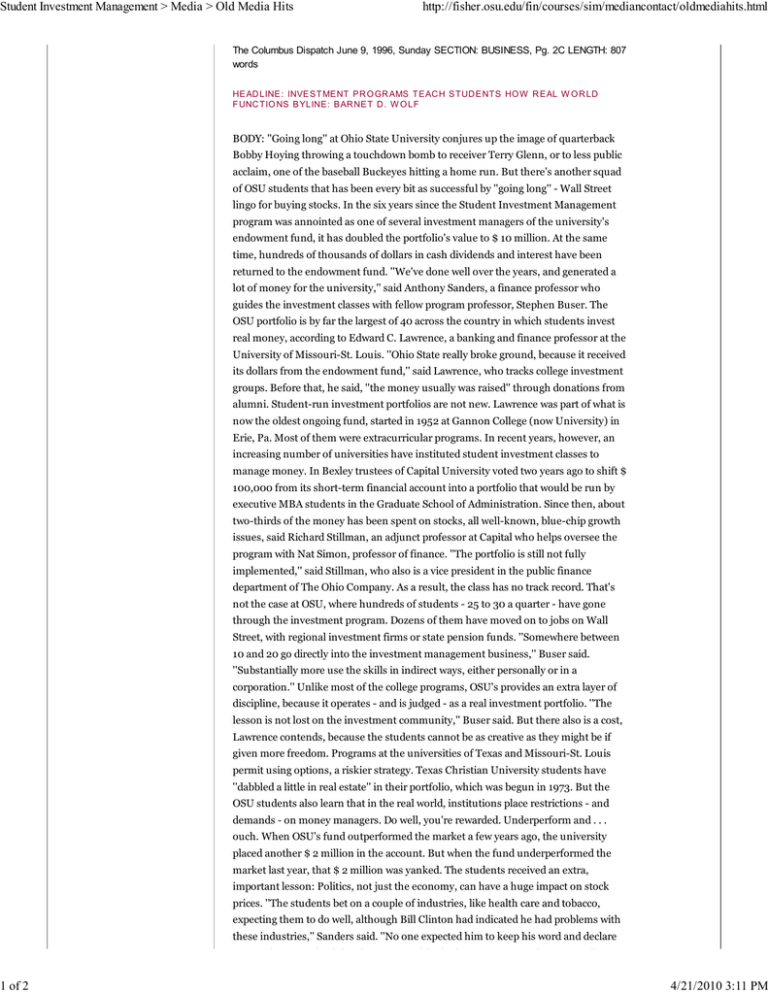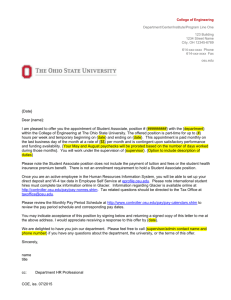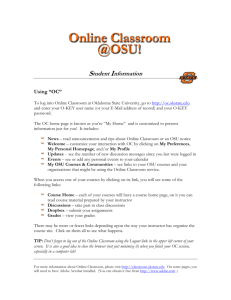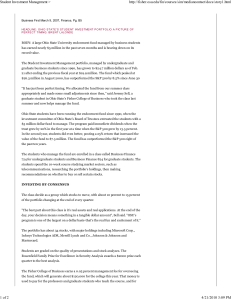Student Investment Management > Media > Old Media Hits
advertisement

Student Investment Management > Media > Old Media Hits 1 of 2 http://fisher.osu.edu/fin/courses/sim/mediancontact/oldmediahits.html The Columbus Dispatch June 9, 1996, Sunday SECTION: BUSINESS, Pg. 2C LENGTH: 807 words HEAD LINE : INVE STMENT PR O GR AMS TEAC H S TUD E NTS HO W R EAL W O R LD FUNC TIO NS B YLINE: BAR NE T D . W O LF BODY: ''Going long'' at Ohio State University conjures up the image of quarterback Bobby Hoying throwing a touchdown bomb to receiver Terry Glenn, or to less public acclaim, one of the baseball Buckeyes hitting a home run. But there's another squad of OSU students that has been every bit as successful by ''going long'' - Wall Street lingo for buying stocks. In the six years since the Student Investment Management program was annointed as one of several investment managers of the university's endowment fund, it has doubled the portfolio's value to $ 10 million. At the same time, hundreds of thousands of dollars in cash dividends and interest have been returned to the endowment fund. ''We've done well over the years, and generated a lot of money for the university,'' said Anthony Sanders, a finance professor who guides the investment classes with fellow program professor, Stephen Buser. The OSU portfolio is by far the largest of 40 across the country in which students invest real money, according to Edward C. Lawrence, a banking and finance professor at the University of Missouri-St. Louis. ''Ohio State really broke ground, because it received its dollars from the endowment fund,'' said Lawrence, who tracks college investment groups. Before that, he said, ''the money usually was raised'' through donations from alumni. Student-run investment portfolios are not new. Lawrence was part of what is now the oldest ongoing fund, started in 1952 at Gannon College (now University) in Erie, Pa. Most of them were extracurricular programs. In recent years, however, an increasing number of universities have instituted student investment classes to manage money. In Bexley trustees of Capital University voted two years ago to shift $ 100,000 from its short-term financial account into a portfolio that would be run by executive MBA students in the Graduate School of Administration. Since then, about two-thirds of the money has been spent on stocks, all well-known, blue-chip growth issues, said Richard Stillman, an adjunct professor at Capital who helps oversee the program with Nat Simon, professor of finance. ''The portfolio is still not fully implemented,'' said Stillman, who also is a vice president in the public finance department of The Ohio Company. As a result, the class has no track record. That's not the case at OSU, where hundreds of students - 25 to 30 a quarter - have gone through the investment program. Dozens of them have moved on to jobs on Wall Street, with regional investment firms or state pension funds. ''Somewhere between 10 and 20 go directly into the investment management business,'' Buser said. ''Substantially more use the skills in indirect ways, either personally or in a corporation.'' Unlike most of the college programs, OSU's provides an extra layer of discipline, because it operates - and is judged - as a real investment portfolio. ''The lesson is not lost on the investment community,'' Buser said. But there also is a cost, Lawrence contends, because the students cannot be as creative as they might be if given more freedom. Programs at the universities of Texas and Missouri-St. Louis permit using options, a riskier strategy. Texas Christian University students have ''dabbled a little in real estate'' in their portfolio, which was begun in 1973. But the OSU students also learn that in the real world, institutions place restrictions - and demands - on money managers. Do well, you're rewarded. Underperform and . . . ouch. When OSU's fund outperformed the market a few years ago, the university placed another $ 2 million in the account. But when the fund underperformed the market last year, that $ 2 million was yanked. The students received an extra, important lesson: Politics, not just the economy, can have a huge impact on stock prices. ''The students bet on a couple of industries, like health care and tobacco, expecting them to do well, although Bill Clinton had indicated he had problems with these industries,'' Sanders said. ''No one expected him to keep his word and declare war on them. But he did.'' The OSU portfolio had grown to as much as $ 11 million 4/21/2010 3:11 PM Student Investment Management > Media > Old Media Hits 2 of 2 http://fisher.osu.edu/fin/courses/sim/mediancontact/oldmediahits.html war on them. But he did.'' The OSU portfolio had grown to as much as $ 11 million before the $ 2 million was taken away. In the past year, however, the students built the fund back to $ 10 million, outperforming the Standard & Poor's 500 in nine of the past 12 months, often substantially. Actually, the student portfolio hasn't changed much in the past year. Its biggest positions - in terms of percentage of assets - are with Paychex, which has tripled in value; Computer Associates International; Worldcom; and General Motors Class E. ''Some people say timing is everything, but we haven't figured out how to teach that,'' Buser said. ''We don't know it ourselves.'' Barnet D. Wolf is assistant business editor of The Dispatch. 4/21/2010 3:11 PM





